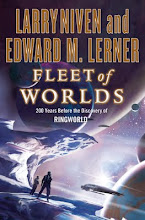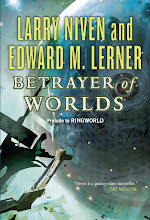An exercise: describe humanity in one word.
Choose carefully. The term you pick must apply universally across nationalities, ethnicities, cultures, technology levels, and political systems. It must apply equally across thousands of years of history, today, and well into the future. The term should also serve to predict the behavior of an individual person in any situation, independent of his or her past experiences, throughout his or her adult life.
Hmm. Humans can be cruel, selfish, and ruthless -- but we can also be altruistic, generous, and self-sacrificing. We can be curious, but we can also be oblivious to events all around us. We can be inventive or mired in tradition or anti-intellectual, slapstick or witty or humorless, adventuresome or stay-at-home. We love and hate. We can be suspicious, sympathetic, and gullible. We act both capriciously and with cold, calculating premeditation.
I'm not having a lot of luck with my own challenge.
I succumb on occasion to checking out comments about my own books, both by professional reviewers and by (via Amazon and Goodreads, for example) the general readership. Most authors do. And while it's always enjoyable to see praise, critiques provide more in the way of learning opportunities. As in: What aspects of a plot did some readers not accept? What character behaviors did some readers find implausible? What background elements might have been insufficiently described?
So: How does that exercise of authorial due diligence (or rationalization -- another human trait) have anything to do with today's challenge?
Monday, September 26, 2011
Humans, Pak, Puppeteers: in one word
Posted by
Edward M. Lerner
at
1:30 PM
Labels:
aliens,
known space,
Larry Niven,
puppeteer,
science fiction,
sociology
Tuesday, September 20, 2011
Everything's spinning out of control!
Okay, that's not a statistical finding -- maybe things are no more out of control than usual. Regardless, my files are bursting with craziness. Such as:
Seismologists in Italy are on trial for manslaughter for failing to warn of a serious earthquake. Who believes seismologists can predict earthquakes? It's madness!
As is, IMO, the growing popularity of burning food (aka, biofuels). From a recent WSJ interview with Peter Brabeck-Letmathe, the chairman of Nestle:
Maybe it does. Read the full article ... Peter Brabeck-Letmathe has much to say about the intersection of policies affecting energy, food, and water. Very interesting stuff.)
Seismologists in Italy are on trial for manslaughter for failing to warn of a serious earthquake. Who believes seismologists can predict earthquakes? It's madness!
As is, IMO, the growing popularity of burning food (aka, biofuels). From a recent WSJ interview with Peter Brabeck-Letmathe, the chairman of Nestle:
"The U.S. Department of Agriculture's most recent estimate predicts that this year, for the first time, American farmers will harvest more corn for ethanol than for feed. In Europe some 50% of the rapeseed crop is going into biofuel production, according to Mr. Brabeck-Letmathe, while 'world-wide about 18% of sugar is being used for biofuel today.'"Despite burning such big portions of the food supply, food prices spike. How can such things happen? If only the world made sense!
Maybe it does. Read the full article ... Peter Brabeck-Letmathe has much to say about the intersection of policies affecting energy, food, and water. Very interesting stuff.)
Posted by
Edward M. Lerner
at
1:10 PM
Labels:
AI,
business of writing,
current events,
robotics,
science
Tuesday, September 13, 2011
Strange worlds
Today's topic: planets and moons in recent news.
The European Southern Observatory (located high in the Chilean mountains) just released its latest exoplanet survey results. Bottom line: about 50 new super Earths, one of these worlds arguably within its star's habitable zone. (That's not to say anyone knows that HD 85512 b is habitable -- we don't know whether it has an atmosphere. But if this world has an atmosphere, the current understanding of planetary dynamics says liquid water could exist on its surface.) From Space Daily, see: "Latest Exoplanet Haul Includes Super Earth At Habitat Zone Edge."
(That article spoke to me because the novel I'm currently writing involves a super Earth.)
Here's another -- and quite different -- exoplanet. Again from Space Daily, see, "Strange planet is blacker than coal." But TrES-2b is not a giant lump of something coal-like. It's a Jupiter-like gas giant, closely orbiting its star. About 3 million kilometers close, its atmosphere heated to 1000 degrees C! So how the blazes (heh!) is that world blacker than acrylic black paint?
The European Southern Observatory (located high in the Chilean mountains) just released its latest exoplanet survey results. Bottom line: about 50 new super Earths, one of these worlds arguably within its star's habitable zone. (That's not to say anyone knows that HD 85512 b is habitable -- we don't know whether it has an atmosphere. But if this world has an atmosphere, the current understanding of planetary dynamics says liquid water could exist on its surface.) From Space Daily, see: "Latest Exoplanet Haul Includes Super Earth At Habitat Zone Edge."
(That article spoke to me because the novel I'm currently writing involves a super Earth.)
Here's another -- and quite different -- exoplanet. Again from Space Daily, see, "Strange planet is blacker than coal." But TrES-2b is not a giant lump of something coal-like. It's a Jupiter-like gas giant, closely orbiting its star. About 3 million kilometers close, its atmosphere heated to 1000 degrees C! So how the blazes (heh!) is that world blacker than acrylic black paint?
Monday, September 5, 2011
Uh-oh
In the past couple weeks, despite the mid-Atlantic, inland location of my home, I've experienced an earthquake and been grazed by Hurricane Irene. As I type, Tropical Storm Lee is headed my way. I've taken to jokingly wondering when the locusts will come --
And yesterday, I noticed grasshoppers in my yard and garage.
It's enough to render current events quite scary.
In this morning's Computerworld: "Hackers steal SSL certificates for CIA, MI6, Mossad." With the stolen certificates, the perps had the ability to launch "man in the middle" attacks, impersonating the named intel agencies, Google, and Facebook, among notworthy organizations. Without details, the above article says Iran is implicated.
And yesterday, I noticed grasshoppers in my yard and garage.
It's enough to render current events quite scary.
In this morning's Computerworld: "Hackers steal SSL certificates for CIA, MI6, Mossad." With the stolen certificates, the perps had the ability to launch "man in the middle" attacks, impersonating the named intel agencies, Google, and Facebook, among notworthy organizations. Without details, the above article says Iran is implicated.
Subscribe to:
Comments (Atom)

































